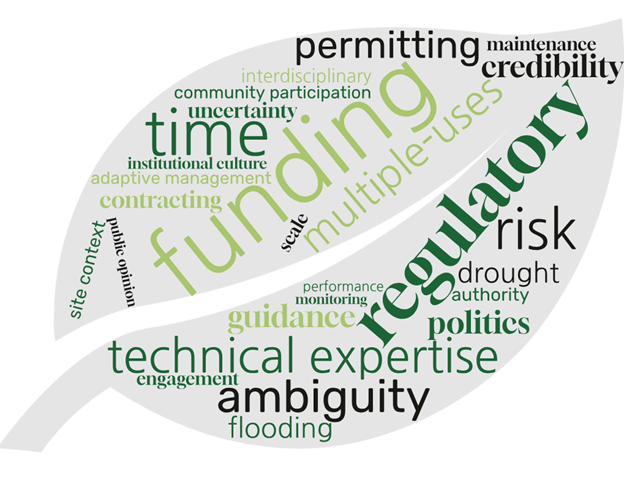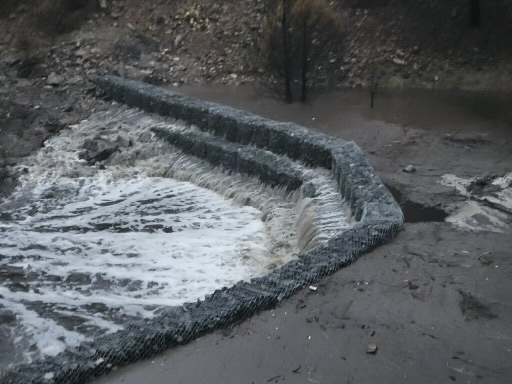The Arid Southwest NNBF Playbook Workshop, held May 7–8, 2025, in Albuquerque, NM, brought together more than 35 participants from over 20 federal, state, tribal, academic, and non-governmental organizations. Hosted by the U.S. Army Corps of Engineers (USACE) in collaboration with the Engineering With Nature® (EWN®) initiative, the workshop was designed to support the development of a practical, science-informed guide—or “playbook”—for implementing Natural Infrastructure (NI) in arid regions. The event aimed to address the increasing risks of drought, flooding, and climate-related impacts in the arid southwest by identifying how to integrate NI into USACE engineering practices. It also sought to overcome regulatory, institutional, and technical barriers to NI adoption by facilitating stakeholder collaboration, advancing understanding of performance expectations, and bolstering confidence in sustainable infrastructure solutions. Central to this effort was the intention to lay a foundation for region-specific guidance that would inform the planning, design, and implementation of NI strategies, ultimately improving long-term resilience, reducing costs, and maximizing community benefit.
Topics Included:
- Advancing integration of NI in USACE engineering solutions.
- Supporting communities facing aridification.
- Inform the development of an NI Playbook.
- Enhancing collaboration across agencies and disciplines.
- Identifing barriers and opportunities for NI adoption.

Workshop Presentations
The workshop was organized around three major themes and included plenary sessions, breakout groups, and interactive polling. Below are the primary topics discussed under each theme:
Setting the Stage: Perspectives and Purpose
- Welcome to the Arid Southwest Natural and Nature-based Feature Workshop – Dr. Aubrey Harris, USACE-ERDC-EL
- USACE Albuquerque District Perspectives on Engineering With Nature – Mark Doles, USACE, SPD
- Engineering with Nature (EWN) – NNBF Implementation Resources and Playbooks – Dr. Burton Suedel, USACE-ERDC-EL
Theme 1: Purposes and Authorities
- What does Social Science have to do with Ecological Engineering? – Dr. Judith Vendrzyk, USACE-ERDC-CERL
- Tijeras Creek Watershed Restoration Project – Stuart Trabant, BHI
- How NNBF can support NMED Programs and How NMED Programs can support NNBF – Alan Klatt, NMED
- Low-Tech Process-Based Restoration on Headwater streams in New Mexico – Karen Menetrey, Rio Grande Return
Theme 2: Design and Implementation
- Stream Applications of Natural & Nature-based Features (NNBF) in the Arid SW – Dr. Chris Haring, USACE-ERDC-CHL
- Natural and Nature-based Features for Roadway Crossings: A Tribal Case Study from a Fire & Flood Impacted Watershed – Garrett Altmann, SCU-EPIC
- Mimicking Beavers – Jonathan AuBuchon, USACE-SPA
- National Forest Foundation’s Colorado River Basin Watershed Program & SW Stage 0 ImplementationKatie Sickmann, National Forest Foundation
Theme 3: Monitoring and Measures
- EWN + landscape architecture – Steven Bailey, USACE-ERDC-CHL
- Honoring Tradition and Building Resilience: Integrating NNBFs into Historic Acequia Systems – Rodrigo Sedeno, USACE-SPA
- Bernalillo County Green Stormwater Infrastructure and Low Impact Development Standards – Kali Bronson, BernCo
- Sands Draw Grassland Restoration Part II – Sediment Traps – Joneen S. Cockman
Preliminary Identified Challenges
- Insufficient flexibility in traditional USACE project planning frameworks.
- Difficulty monitoring and linking project performance with design objectives.
- Barriers in permitting, funding, long-term planning, and technology transfer.
- Ambiguity in guidance and varied organizational priorities.







